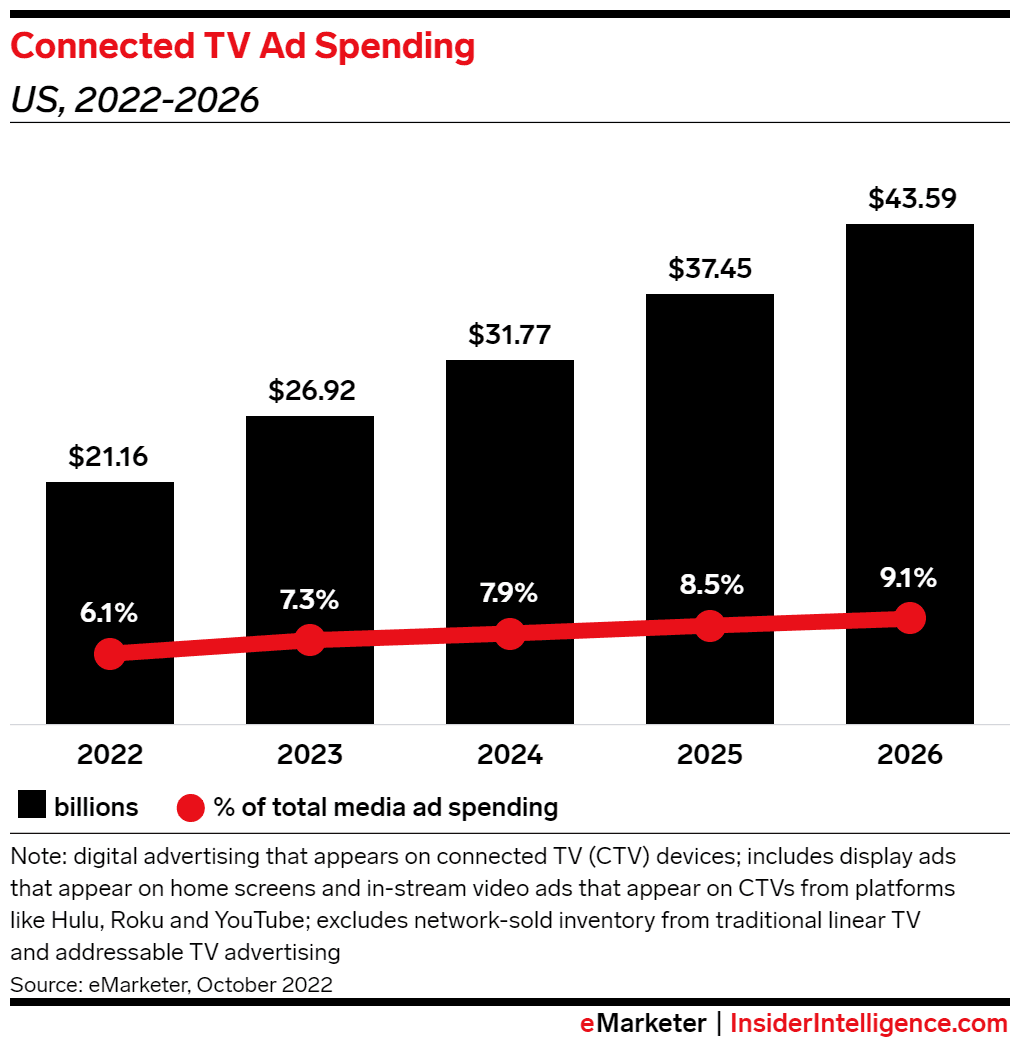

What is Connected TV and Why Every Top Marketer Needs to Know About it
The CTV train has arrived.

Garrett Dale
Chief Partnership Officer, Kepler Group
The everyday person turning on their television likely isn’t putting too much thought into the mechanics behind how it’s all delivered to them beyond “what channel or app is the show on”, and they navigate appropriately from there. Yet, as marketers and media buyers trying to reach these prospective consumers, we know the underlying technology of TV content distribution matters – either through a set top box or streaming via Connected TV devices – and it directly impacts how we plan, buy, and measure the impact of the ads on the biggest screens in the living quarters.
We’re talking about this now because in the last four years, traditional TV viewership has steadily declined, while adult CTV viewership has doubled to nearly 2 hours a day1. In parallel, the tools to thoughtfully transact and deliver relevant ads within CTV have dramatically improved, making CTV accessible, effective, and efficient. In this introduction to CTV, we will clearly define the device and advertising opportunity, helping you, the marketer, make the case why your brand should be omnipresent on CTV through proven use cases and results.
First thing’s first: What is Connected TV (CTV)?
A Connected TV is:
A television set with a native connection to the Internet (also known as a “smart TV”)
A television set that connects to the Internet through an external device such as:
A streaming stick, e.g., Chromecast, Fire Stick, Roku stick, Apple TV
A media player/gaming device, e.g., XBOX, Playstation
Connected TV Ads are:
Any ads served on a television, through the internet (not a set top / cable box). Most often, these are in the form of video ads, often called “spots”, and typically run 15 or 30 seconds long, as you’d see in more traditional linear TV buys. However, we’ll talk more about emerging innovation within CTV ad formats later that allow for increased interaction and opportunities to natively integrate brands into the viewing experience.
Used in a “real world” yet hypothetical situation: As a media buyer for Nike, you’ve uncovered through data-driven media planning and analytics tools that your desired strategic audience of those with a “high propensity to buy Nikes” over-indexes in watching the show “Atlanta” on Hulu/FX and they prefer seeing ads on a TV versus a mobile device. Therefore, you’d like to place a :15 second “Connected TV” video ad within “Atlanta” on Hulu/FX, on living room TV screens”.
Key components of this request:
Device: Connected TV, with a clarification that you only want the TV screens, not mobile app/browser, or laptop browser inventory that is included in the “OTT” (Over-the-Top) bucket. More on this shortly.
Spot: :15 second video ad
Placement / Show: Atlanta
Network / Media Owner: Hulu/FX sold by Disney
What is the difference between Connected TV (CTV) and Over-the-Top video (OTT)?
CTV and OTT are often mistakenly used synonymously. We’re here to help clear it up once and for all. These two descriptors actually mean different things.
OTT is a catch-all term for video content delivered over the internet, regardless of the device. An easy way to think of the difference is that CTV is the device used to watch content via the internet - think Smart TV, Firestick, XBOX, etc. OTT is TV-like content viewed online, no matter what device you use.
For example, let’s say you’re watching Netflix on your LG Smart TV. Netflix is OTT content, and your LG Smart TV is the connected TV device.
CTV is the TV device used to watch, or “stream”, content via the internet, whereas OTT is TV-like content that you’re “streaming” online, on any device.
Or, if you’re like most of us and you’ve been streaming Ted Lasso, perhaps on your iPad’s Apple TV app – Ted Lasso is the OTT video content, and your mobile phone is the device. However, a mobile phone is not considered Connected TV, even though it’s still valuable premium video content.
Pro Tip: if your brand requires premium video on the big screen, make sure your media partners and tools are serving only on CTV and not across all OTT inventory.
3 reasons why top brands need to be advertising on Connected TVs (CTV)
It works.
Whether you’re introducing a new product or driving further brand loyalty, the big screen has a history of being a trusted advertising medium that influences real world actions, both online and in-store. From awareness to performance needs, CTV can be an integral part of your marketing plan.
Luxury CPG brand was able to drive growth across key brand lift metrics (Kantar Milward Brown 2022, Roku Case Study)
+51% lift in awareness
+42% lift in brand favorability
+190% lift in consideration intent
2. Your competition is there.
And if they aren’t, they’re planning on it right now. The IAB expects CTV ad spending to grow by 14.4%; while traditional linear ad spending to decrease by 6.3% in 2023.
According to a recent Pixability study, 76% of agencies say clients will increase spending in CTV, 20% said they would maintain their investment, and 4% predict a slight decrease in CTV media investments. Additionally, respondents stated that most agencies are considering YouTube to be a part of CTV too, and will be an integral part of their CTV strategy and planning.

3. Your customers and future customers are there.
As noted at the top of the article, US adults will spend an average of nearly 2 hours per day using a CTV device, citesInsider Intelligence1. Where the eyeballs go, there to go advertisers, especially once ad technology has matured to more efficiently plan, buy, optimize, and measure the media – as it has, through platforms like Display & Video 360 (DV360) within Google Marketing Platform (GMP).

Taking the next step, advertising on Connected TV (CTV):
The days of only the biggest brands in the world owning all of the TV ad real estate are behind us. With Napkyn in your corner, the big screen is accessible and a driver of real business outcomes. Napkyn will make sure your team is fully trained and set up for success on CTV, complementing the entire marketing plan, through advanced technology platforms like Google’s DV360 and the rest of the Google Marketing Platform and Google Ads.
Interested in learning more and growing your business through CTV? Email us today.
----------------------------------------
Cited Sources in this blog post
1: US Adults Will Spend Nearly 2 Hours a Day With CTV Devices This Year
More Insights


Ready for What? AI Readiness in Marketing Today

Jasmine Libert
Senior Vice President, Data Solutions
Apr 30, 2025
Read More


BigQuery for Marketers: Combine GA4, Google Ads & CRM Data for Smarter Decision

Shreya Banker
Data Scientist
Apr 23, 2025
Read More


How to Audit Google Analytics 4 (GA4): Common Issues and Their Impacts on Your Data

Hasan Alanam
Manager, Data Solutions
Apr 7, 2025
Read More
More Insights
Sign Up For Our Newsletter

Napkyn Inc.
204-78 George Street, Ottawa, Ontario, K1N 5W1, Canada
Napkyn US
6 East 32nd Street, 9th Floor, New York, NY 10016, USA
212-247-0800 | info@napkyn.com

What is Connected TV and Why Every Top Marketer Needs to Know About it
The CTV train has arrived.

Garrett Dale
Chief Partnership Officer, Kepler Group
The everyday person turning on their television likely isn’t putting too much thought into the mechanics behind how it’s all delivered to them beyond “what channel or app is the show on”, and they navigate appropriately from there. Yet, as marketers and media buyers trying to reach these prospective consumers, we know the underlying technology of TV content distribution matters – either through a set top box or streaming via Connected TV devices – and it directly impacts how we plan, buy, and measure the impact of the ads on the biggest screens in the living quarters.
We’re talking about this now because in the last four years, traditional TV viewership has steadily declined, while adult CTV viewership has doubled to nearly 2 hours a day1. In parallel, the tools to thoughtfully transact and deliver relevant ads within CTV have dramatically improved, making CTV accessible, effective, and efficient. In this introduction to CTV, we will clearly define the device and advertising opportunity, helping you, the marketer, make the case why your brand should be omnipresent on CTV through proven use cases and results.
First thing’s first: What is Connected TV (CTV)?
A Connected TV is:
A television set with a native connection to the Internet (also known as a “smart TV”)
A television set that connects to the Internet through an external device such as:
A streaming stick, e.g., Chromecast, Fire Stick, Roku stick, Apple TV
A media player/gaming device, e.g., XBOX, Playstation
Connected TV Ads are:
Any ads served on a television, through the internet (not a set top / cable box). Most often, these are in the form of video ads, often called “spots”, and typically run 15 or 30 seconds long, as you’d see in more traditional linear TV buys. However, we’ll talk more about emerging innovation within CTV ad formats later that allow for increased interaction and opportunities to natively integrate brands into the viewing experience.
Used in a “real world” yet hypothetical situation: As a media buyer for Nike, you’ve uncovered through data-driven media planning and analytics tools that your desired strategic audience of those with a “high propensity to buy Nikes” over-indexes in watching the show “Atlanta” on Hulu/FX and they prefer seeing ads on a TV versus a mobile device. Therefore, you’d like to place a :15 second “Connected TV” video ad within “Atlanta” on Hulu/FX, on living room TV screens”.
Key components of this request:
Device: Connected TV, with a clarification that you only want the TV screens, not mobile app/browser, or laptop browser inventory that is included in the “OTT” (Over-the-Top) bucket. More on this shortly.
Spot: :15 second video ad
Placement / Show: Atlanta
Network / Media Owner: Hulu/FX sold by Disney
What is the difference between Connected TV (CTV) and Over-the-Top video (OTT)?
CTV and OTT are often mistakenly used synonymously. We’re here to help clear it up once and for all. These two descriptors actually mean different things.
OTT is a catch-all term for video content delivered over the internet, regardless of the device. An easy way to think of the difference is that CTV is the device used to watch content via the internet - think Smart TV, Firestick, XBOX, etc. OTT is TV-like content viewed online, no matter what device you use.
For example, let’s say you’re watching Netflix on your LG Smart TV. Netflix is OTT content, and your LG Smart TV is the connected TV device.
CTV is the TV device used to watch, or “stream”, content via the internet, whereas OTT is TV-like content that you’re “streaming” online, on any device.
Or, if you’re like most of us and you’ve been streaming Ted Lasso, perhaps on your iPad’s Apple TV app – Ted Lasso is the OTT video content, and your mobile phone is the device. However, a mobile phone is not considered Connected TV, even though it’s still valuable premium video content.
Pro Tip: if your brand requires premium video on the big screen, make sure your media partners and tools are serving only on CTV and not across all OTT inventory.
3 reasons why top brands need to be advertising on Connected TVs (CTV)
It works.
Whether you’re introducing a new product or driving further brand loyalty, the big screen has a history of being a trusted advertising medium that influences real world actions, both online and in-store. From awareness to performance needs, CTV can be an integral part of your marketing plan.
Luxury CPG brand was able to drive growth across key brand lift metrics (Kantar Milward Brown 2022, Roku Case Study)
+51% lift in awareness
+42% lift in brand favorability
+190% lift in consideration intent
2. Your competition is there.
And if they aren’t, they’re planning on it right now. The IAB expects CTV ad spending to grow by 14.4%; while traditional linear ad spending to decrease by 6.3% in 2023.
According to a recent Pixability study, 76% of agencies say clients will increase spending in CTV, 20% said they would maintain their investment, and 4% predict a slight decrease in CTV media investments. Additionally, respondents stated that most agencies are considering YouTube to be a part of CTV too, and will be an integral part of their CTV strategy and planning.

3. Your customers and future customers are there.
As noted at the top of the article, US adults will spend an average of nearly 2 hours per day using a CTV device, citesInsider Intelligence1. Where the eyeballs go, there to go advertisers, especially once ad technology has matured to more efficiently plan, buy, optimize, and measure the media – as it has, through platforms like Display & Video 360 (DV360) within Google Marketing Platform (GMP).

Taking the next step, advertising on Connected TV (CTV):
The days of only the biggest brands in the world owning all of the TV ad real estate are behind us. With Napkyn in your corner, the big screen is accessible and a driver of real business outcomes. Napkyn will make sure your team is fully trained and set up for success on CTV, complementing the entire marketing plan, through advanced technology platforms like Google’s DV360 and the rest of the Google Marketing Platform and Google Ads.
Interested in learning more and growing your business through CTV? Email us today.
----------------------------------------
Cited Sources in this blog post
1: US Adults Will Spend Nearly 2 Hours a Day With CTV Devices This Year
More Insights

Ready for What? AI Readiness in Marketing Today

Jasmine Libert
Senior Vice President, Data Solutions
Apr 30, 2025
Read More

BigQuery for Marketers: Combine GA4, Google Ads & CRM Data for Smarter Decision

Shreya Banker
Data Scientist
Apr 23, 2025
Read More

How to Set Up GA4 Ecommerce Tracking (Without Data Loss) | A Complete Step-by-Step Guide

Ricardo Cristofolini
Senior Implementation Specialist, Data Solutions
Apr 16, 2025
Read More
More Insights
Sign Up For Our Newsletter


